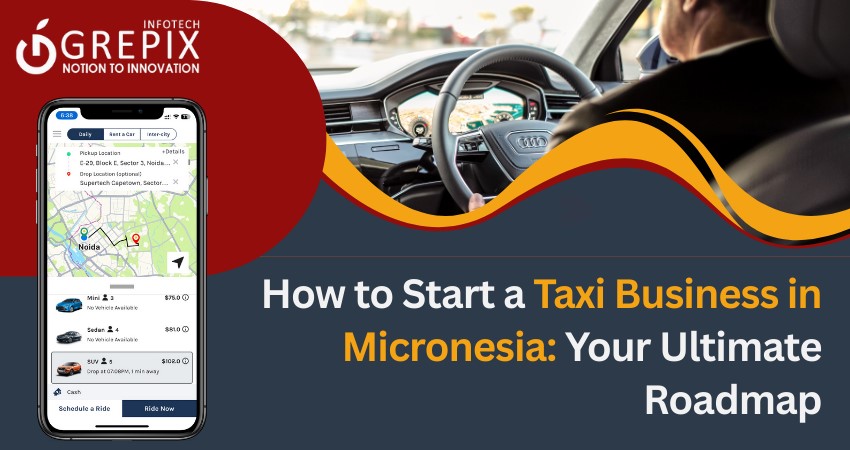How to Start a Taxi Business in Micronesia: Your Ultimate Roadmap
Micronesia, a stunning region in the western Pacific Ocean, is made up of thousands of small islands with incredible cultural richness and natural beauty. But despite its charms, one thing it lacks is efficient, reliable, and modern transportation systems. That's where you come in. Starting a taxi business in Micronesia isn't just a smart idea, it's a much-needed solution that can significantly improve the daily lives of locals and enhance the experience of tourists. With the help of Grepix Infotech's powerful taxi app software, your venture can go from idea to operational in no time. This ultimate roadmap walks you through every essential step from planning, legalities, and vehicle setup to launching a high-performance taxi app to dominate the market.
Thinking about launching a taxi business in Micronesia? This detailed roadmap covers everything you need to know from understanding the market and obtaining licenses to setting up your fleet and launching a feature-rich taxi booking app. Micronesia's growing demand for dependable transport makes it the perfect place for a ride-hailing startup. With Grepix Infotech's white-label taxi software, you get a fully customizable, easy-to-deploy app that suits both local and tourist needs. From fare calculation and GPS tracking to driver management and customer support, Grepix has you covered. This article walks you through legal steps, vehicle planning, driver hiring, and smart marketing tactics all tailored for Micronesia's unique geography. With proper strategy and the right tech, your taxi business can grow into a trusted transport solution across the islands.
1An Overview of Micronesia's Transport Landscape
1. Transportation Needs and Opportunities in Micronesia
The Federated States of Micronesia comprises four states spread across the Pacific: Yap, Chuuk, Pohnpei, and Kosrae. Each island has its own challenges when it comes to transportation. Public transportation is minimal, often unreliable, and frequently consists of shared vans or boats. Taxis, when available, operate informally and usually without any standardized fare system or app-based booking.
That's where the opportunity lies. With urban centers like Kolonia in Pohnpei growing steadily and tourism increasing, especially in dive-friendly areas, modern transportation services are in high demand. Tourists want reliable, on-demand rides. Locals need affordable, safe commutes. Starting a professional taxi service supported by modern software fills a massive gap in the market.
2. Local Commuter Behavior and Tourism Influence
Local commuting in Micronesia is primarily done through private vehicles, walking, and informal taxis. While these options work to some extent, they're not reliable or scalable. Add to this the influx of tourists looking for convenient airport pickups, sightseeing rides, and inter-island transport and you've got a recipe for a booming taxi business.
Tourism is a key economic driver in Micronesia. A branded, tech-savvy taxi business can form partnerships with resorts, dive operators, and travel agencies to offer specialized services, setting you apart from the competition and attracting more business.
2Laying the Groundwork: Market Research & Strategy
1. Identifying Your Audience
To build a taxi business that truly serves its customers, you must first define your target audience. In Micronesia, you'll be catering to:
- Local workers and students needing daily commute options
- Tourists looking for reliable and safe transport
- Government officials and professionals requiring scheduled rides
- Businesses in need of delivery or transport logistics
Each segment has different expectations in terms of pricing, ride experience, and reliability. Your business model and app features should reflect these needs to maximize engagement and profits.
2. Studying Competitors and Transportation Gaps
Research existing taxi providers, ride options, and customer reviews. Are there any tech-enabled services already operating? If so, what are their weaknesses? If not, even better, you can be the first mover.
Look at pricing structures, service availability, and customer feedback. Pay attention to pain points like:
- Long wait times
- Unpredictable pricing
- Poor vehicle conditions
- Language barriers with drivers
Filling these gaps with a well-trained fleet, fixed or digital fares, and a seamless app-based experience can position your business as the go-to ride service in Micronesia.
3. Drafting a Strong Business Plan
A business plan is your blueprint for success. Here's what to include:
- Business Goals: Define your mission, vision, and short and long-term objectives.
- Operational Structure: Number of vehicles, staffing, routes, and service areas.
- Pricing Model: Competitive yet profitable pricing strategies.
- Marketing Strategy: Online and offline marketing to reach your audience.
- Revenue Forecast: Startup costs, expected income, and break-even analysis.
- Technology Stack: Plan your tech requirements, highlighting Grepix Infotech's role as your tech partner.
A solid plan not only keeps you focused but also helps when applying for funding or government support.
3Legal Setup and Government Requirements
1. Business Registration and Licensing
To operate legally in Micronesia, you must register your taxi business with the local government office in your respective state (Pohnpei, Chuuk, etc.). This usually involves:
- Choosing a business name
- Registering your business structure (sole proprietorship, partnership, or company)
- Obtaining a tax ID>
- Applying for a transportation business license
Local business bureaus or trade offices can provide forms and guidance. Make sure all documents are submitted and approved before you begin operations.
2. Insurance and Safety Guidelines
Every vehicle must be insured. In Micronesia, this typically includes third-party liability and accident insurance. It's also a good idea to get comprehensive insurance to cover damages, theft, and natural disasters, which are more common in island nations.
Additionally, local regulations may require safety checks or vehicle inspections before issuing taxi permits. Ensure every vehicle is equipped with:
- Seat belts
- Fire extinguishers
- First-aid kits
- GPS trackers (especially useful for app integration)
3. Driver and Vehicle Permits
Your drivers must have valid licenses, preferably commercial ones, and may need to undergo additional verification or health checks depending on local rules. Background checks and customer service training are recommended even if not legally required to build customer trust.
Each vehicle should be registered as a commercial vehicle and display appropriate taxi signage. Compliance ensures smooth operation and protects your brand's reputation.
Also Read: "Accelerating Your Fortune: Becoming a Billionaire in South Africa's Taxi Industry"
4Building and Managing a Taxi Fleet
1. Choosing the Right Vehicles
Choosing the right vehicles depends on your target audience. For tourists, consider larger vehicles with luggage space or air-conditioning. For city commuting, compact cars are more fuel-efficient and easier to navigate through narrow roads.
Ensure your fleet includes:
- Budget-friendly sedans for locals
- Vans for group tours or airport transfers
- Specialty vehicles for high-end services
Also consider vehicles with better fuel efficiency and lower maintenance costs, especially since spare parts might be limited on remote islands.
2. Buying vs Leasing: Pros and Cons
Buying Vehicles:
- Pros: Full ownership, long-term savings, ability to customize.
- Cons: High upfront investment, maintenance responsibility.
Leasing Vehicles:
- Pros: Lower upfront cost, easier to upgrade fleet, maintenance sometimes included.
- Cons: Monthly costs, mileage limits, no ownership.
The right choice depends on your budget, fleet size, and operational goals. Some businesses even use a hybrid model—buying core fleet vehicles and leasing the rest for seasonal or tourist demand.
3. Fleet Maintenance and Monitoring
Downtime means lost income. Set up a preventive maintenance schedule including:
- Oil and brake checks
- Tire inspections
- Engine diagnostics
- Cleaning and interior upkeep
Using a fleet management system like the one offered by Grepix Infotech helps track service intervals, fuel efficiency, and vehicle health. Integrating this with your driver app ensures real-time alerts and efficient usage.
5Developing a Taxi App with Grepix Infotech
1. Why Your Taxi Business Needs an App
In today's digital-first world, running a taxi business without a mobile app is like running a restaurant without a menu. Customers in Micronesia, especially tourists and the younger crowd, expect:
- Easy booking via mobile
- Real-time tracking
- Digital payments
- Fare estimation
- Driver ratings and reviews
A robust app improves customer satisfaction, operational efficiency, and brand visibility.
2. Features of Grepix Infotech's Taxi Solution
Grepix Infotech offers a powerful white-label taxi app solution. It includes:
- Rider App: Real-time ride booking, fare calculator, payment gateway, and feedback system.
- Driver App: Ride alerts, navigation, earnings tracking, and shift scheduling.
- Admin Dashboard: Monitor all rides, manage drivers, track payments, and view analytics.
- Dispatcher Panel: Manual ride assignment and customer support.
It's scalable, multilingual, and supports local currency perfect for businesses launching in diverse markets like Micronesia.
3. Grepix's Customization for Micronesia
Grepix doesn't believe in one-size-fits-all. They localize your app to match Micronesia's needs:
- Language and currency adaptation
- Support for offline booking features
- Location-based ride preferences
- Integration with local payment systems
They also help you with branding logo, color scheme, and app store optimization, so your taxi business feels native to Micronesia from day one.
6Marketing and Promoting Your Taxi Business
1. Building a Strong Brand in Micronesia
Branding is more than just a logo, it's about how people feel when they think of your service. In a small community-based society like Micronesia, brand perception spreads fast. Your goal should be to appear reliable, modern, safe, and friendly.
Start by choosing a catchy, local-friendly brand name. Use bright colors and a logo that's easily recognizable. All your vehicles, driver uniforms, and marketing materials should carry your brand consistently.
Your app interface should reflect local culture Grepix allows complete customization, from the splash screen to language settings. This not only improves user experience but makes your brand relatable.
Also, consider community engagement. Sponsor local events, support school programs, or create a customer loyalty scheme. This makes your business not just a transport service but a part of the community.
2. Online and Offline Advertising Strategies
Micronesia's digital usage is increasing, especially in urban centers. Social media platforms like Facebook and Instagram are widely used. Start with targeted ads for app downloads, promotions, or free first rides.
Create engaging content videos of driver stories, customer testimonials, or behind-the-scenes clips of your business. Collaborate with influencers or travel bloggers visiting Micronesia to tap into the tourism market.
Offline strategies are equally important. Distribute flyers near airports, hotels, and local markets. Add branded banners on your taxis. Partner with tourism agencies and local hotels to offer exclusive deals for tourists who use your service.
Offer referral rewards to spread the word. Word-of-mouth is powerful, especially in tight-knit communities.
3. Special Promotions and Tourist Packages
To attract more riders, offer flexible ride packages:
- Airport Transfers: Pre-booked pickups with luggage assistance.
- Hourly Rentals: Ideal for city tours or business meetings.
- Group Discounts: For friends or family traveling together.
- Event Transportation: Weddings, festivals, or official ceremonies.
With Grepix's coupon and promotion engine, you can automate discounts, flash sales, and loyalty rewards. This helps increase rider retention and boost brand loyalty.
7Growth and Expansion Strategy
1. Adding More Locations and Islands
Once your service is stable in one city, plan to expand. Micronesia's geography makes this both challenging and full of potential. Each island state Yap, Chuuk, Kosrae, and Pohnpei has its own economic activity and travel demand.
Before expanding:
- Conduct local surveys
- Hire island-based managers
- Customize services to match terrain (vans for rough roads, small cars for cities)
Grepix's software is built for scalability. You can manage multiple cities, states, or even different brands from one admin panel.
2. Partnering with Local Businesses
Build partnerships with:
- Hotels and Resorts: Offer exclusive packages to their guests
- Event Organizers: Provide VIP transport during festivals or weddings
- Tour Operators: Bundle transport with sightseeing tours
- Airlines and Travel Agencies: Sell ride vouchers with ticket bookings
Collaborative marketing not only reduces advertising costs but also builds credibility.
3. Monitoring Performance and Customer Feedback
Your success relies on consistent performance monitoring. Use Grepix's analytics dashboard to check:
- Driver performance
- Ride completion rates
- Customer ratings
- Peak usage hours
- Popular routes
Regularly analyze this data to optimize your business. If riders consistently rate a route poorly, investigate the issue. If one island underperforms, tweak your strategy.
Also, encourage reviews and feedback through the app. Offer small discounts or rewards for submitting feedback. Customer input is gold, it tells you what's working and what's not.
Conclusion
Staring a taxi business in Micronesia may seem complex, but with the right roadmap and a trusted tech partner, it's entirely achievable and incredibly rewarding. This island nation is rich in culture and brimming with opportunity, especially in the mobility space where reliable transport is limited and demand is growing. Whether you're catering to tourists exploring paradise or locals commuting to work, your taxi business fills a crucial gap. From identifying market needs and managing fleets to complying with legal requirements and embracing modern technology every step plays a role in your success.
Grepix Infotech a leading taxi app development company streamlines the hardest parts by providing a white-label taxi software solution tailored specifically for entrepreneurs like you. Our platform is fast to launch, easy to scale, and customizable for Micronesia's unique needs.
So if you're ready to turn your vision into a real business that delivers value to your community while building a brand, the road starts here with you and Grepix paving the way.
FAQs
1. Is Grepix's taxi app software suitable for Micronesian internet speeds?
Yes, Grepix's platform is optimized for low-bandwidth environments, ensuring seamless performance even in areas with slower internet.
2. How long does it take to launch a taxi business with Grepix?
With Grepix's ready-made platform, you can go live within 7–10 days after finalizing your requirements and branding.
3. Can I offer different pricing on each island or city?
Absolutely. Grepix's dashboard allows location-based pricing models for flexible fare management.
4. What kind of customer support does Grepix provide?
Grepix offers 24/7 technical support, app updates, and backend maintenance, ensuring your business never slows down.
5. Does Grepix help with app store publishing and setup?
Yes, Grepix handles full deployment on Google Play and Apple App Store, along with admin panel training.
Looking out to start your own venture like Uber? Try out our HireMe Taxi Uber Clone, the easiest way to kick-start your taxi business.








